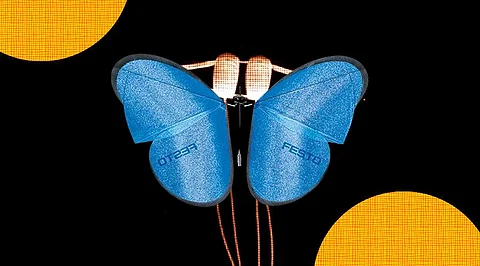

In yet another breakthrough in robotic biomimicry, scientists have released a Mantaray-inspired soft robot. It is a butterfly robot that can swim more than four times faster than its predecessors. A research paper, "Snapping for high-speed and high-efficient, butterfly swimming-like soft flapping-wing robot", published by North Carolina State University reveals how the mechanism of the Butterfly robot is close to energy conserving biomechanics of Mantaray. They named it butterfly robot after the way the robot flaps its arms similar to that of a butterfly stroke in swimming. Jie Yin, one of the co-authors says the soft robots were so far able to have a maximum speed of one body per second but by designing a robot based on the energy-efficient system Mantaray has, he said they could make a swimming robot that can move faster than whale a or a shark. "We wanted to draw on the biomechanics of these animals to see if we could develop faster, more energy-efficient soft robots. The prototypes we've developed work exceptionally well", said the scientist.
They developed two types of butterfly bots, one that can reach a speed of 3.74 body lengths per second, which is 4.8 times faster than the reported fastest flapping soft swimmer, and the other one with sideway maneuverability, one that can take sharp turns to the left or right with a high turning speed of 157 °/sec and move with a speed of 1.7 body lengths per second. The soft robotic swimmer can achieve a higher Strouhal number between 0.2 and 0.4 for efficient propulsion– which is used to assess the energy efficiency of flying and swimming animals relating to forward speed, amplitude, and flapping frequency – while its value varies between 0.25 and 0.35 for flapping foils. The swimming bots weigh only 2.8g.
The current design for faster swimming soft robots varies significantly from the one used for flapping robots, says Yin. He says they adopted a bistable wing mechanism instead of giving movement to wings with attached motors. The hair clip-modelled bistable wing mechanism essentially works by activating the wings passively with the movement of the central body, a mechanism that helped them reduce their weight drastically. The wings attached to the silicone-made body flap back and forth when the air chambers inflate and deflate bending the body up and down achieving two stable states.
The two variations are achieved with a different number of drive units attached to its wings. While the faster robot is attached to one drive unit to give it a better speed with restricted sideways movement, the maneuverable bot is equipped with two drive units so that only one of its wings can be activated for it to take a sideway turn. Yin opines, although the prototype provides a promising proof of concept, it is not without limitations. For butterfly bots, the central body is tethered with pumping tubes adding significant weight to the body. He said they are working to improvise it into an untethered and autonomous one.
Join our WhatsApp Channel to get the latest news, exclusives and videos on WhatsApp
_____________
Disclaimer: Analytics Insight does not provide financial advice or guidance. Also note that the cryptocurrencies mentioned/listed on the website could potentially be scams, i.e. designed to induce you to invest financial resources that may be lost forever and not be recoverable once investments are made. You are responsible for conducting your own research (DYOR) before making any investments. Read more here.
